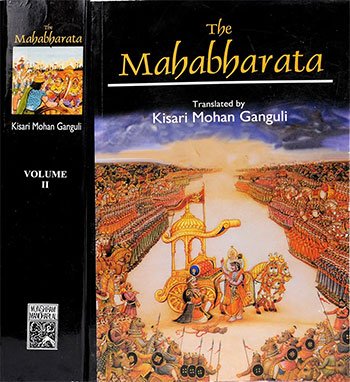Section CIV - Fierce Battle Between Bhishma and Pandavas: Sanjaya's Account
Book index: Mahabharata (English)
This page contains a summary of the Mahabharata Section CIV including examples of moral lessons in daily life. The Maha-Bharata is one of the largest epics ever written containing roughly 100,000 Sanskrit verses. It deals with the legendary history of ancient India and contains a large number of interwoven tales.
Short summary of the chapter:
A fierce battle took place at mid-day between Bhishma and the Pandavas, with Bhishma causing great carnage by piercing them with numerous arrows. Despite being attacked by Dhrishtadyumna, Drupada, Virata, and Sikhandin, Bhishma retaliated by piercing them with his own arrows, causing them to be filled with wrath. The Pandava warriors, including Yudhishthira, the sons of Draupadi, and Satayaki, rushed to protect the Pancalas led by Dhrishtadyumna, while the Kaurava army prepared to defend Bhishma. The battlefield was filled with chaos and destruction as elephants, horses, and foot soldiers fought fiercely, with many being killed on both sides.
Amidst the chaos, elephants ran wild, crushing foot soldiers and destroying cars, while horse riders, deprived of their horses, were seen running on foot in the battlefield. The river of blood flowed through the battlefield, with bows, arrows, and weapons forming its banks, and fallen warriors’ bodies adding to its gruesome appearance. Many Kshatriyas bravely sought to cross this river of blood using cars, elephants, and steeds as makeshift rafts and boats. The Kshatriyas lamented the senseless carnage caused by Duryodhana's greed and expressed their admiration for the virtues of the Pandavas, while criticizing the sinful actions of the Kauravas.
The combatants, witnessing the devastation caused by the battle, lamented the destruction of lives and lamented Duryodhana's actions that had led to this tragic situation. The battle resumed with intensified ferocity, as Duryodhana urged Bhishma, Drona, Kripa, and Salya to fight without boastfulness. Sanjaya highlighted the dreadful consequences of rejecting good counsel and warned that the destruction of kinsmen was either a result of Destiny or Duryodhana's evil policies. The narrative emphasized the senseless loss of lives on both sides due to the greed and ambition of a few individuals, leading to a tragic and devastating outcome on the battlefield.
Full English translation:
This page is merely a summary which is automatically generated. If you are looking for authentic sources such as the Sanskrit text or the Full English translation of Mahabharata Section CIV - Fierce Battle Between Bhishma and Pandavas: Sanjaya's Account, have a look at the following articles:
Section CIV, online text
English translation by Kisari Mohan Ganguli.
Read this and other chapters online.
Mahabharata (English Summary)
by Kisari Mohan Ganguli | ISBN-10: 8121505933
Buy the latest edition:
FAQ of Mahabharata, Section CIV:
What sparked the fierce battle between Bhishma and the Somakas?
The battle was sparked by Bhishma consuming the ranks of the Pandavas.
How did the prominent warriors fare in the battle?
Dhrishtadyumna, Sikhandin, Virata, and Drupada fought fiercely against Bhishma.
What was the outcome of the battle between the Kurus and Pandavas?
The battle, caused by dice match, resulted in an awful slaughter.
Daily life: Fierce Battle Between Bhishma and Pandavas: Sanjaya's Account:
The story vividly portrays the devastating consequences of conflict, emphasizing the importance of resolving differences peacefully. It teaches that holding onto grudges and engaging in battles, driven by pride or greed, only leads to destruction and sorrow, affecting both sides of the conflict. It is crucial to adopt forgiveness, understanding, and open communication to avoid needless suffering.
We should strive to reconcile disagreements through dialogue and mutual respect, acknowledging that the cost of conflict far outweighs the temporary satisfaction of victory. The narrative encourages us to consider the long-term impacts of our actions and to choose paths that promote peace and harmony.
Applying these lessons in daily life involves prioritizing relationships and community wellbeing over winning arguments or being right. By doing so, we not only prevent personal loss and regret but also contribute to creating a more compassionate and understanding world.
